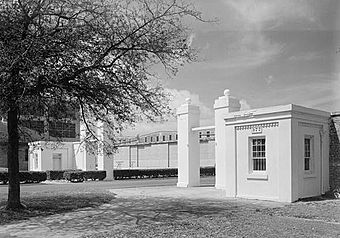Pensacola Naval Air Station Historic District facts for kids
|
Pensacola Naval Air Station Historic District
|
|

Gatehouses and Gates
|
|
| Location | Warrington, Florida |
|---|---|
| Nearest city | Pensacola |
| Area | 82 acres (33 ha) |
| Built | 1824-1899, 1914 |
| NRHP reference No. | 76000595 |
Quick facts for kids Significant dates |
|
| Added to NRHP | December 8, 1976 |
| Designated NHLD | December 8, 1976 |
The Pensacola Naval Air Station Historic District is a special area in Warrington, Florida, near Pensacola. It protects the oldest parts of Naval Air Station Pensacola. This historic district includes buildings from the old Pensacola Navy Yard. It also has structures used when the United States Navy first started training pilots to fly airplanes. This important area was named a National Historic Landmark in 1976.
Contents
The Pensacola Naval Air Station Historic District is located in the southeast part of the modern Naval Air Station Pensacola. It covers about 82 acres (33 hectares). This area used to be the walled part of the Pensacola Navy Yard.
Buildings and Their History
The district has buildings from after the American Civil War. It also includes early structures used for training naval aviators. These pilots learned to fly seaplanes, which are planes that can land on water.
You can find the original house of the navy yard commander here. There are also residential barracks where people lived. An old chapel from 1865 is part of the district too. Many other service buildings are also there. These buildings have been used for different things over the years. When it became a National Historic Landmark, there were 55 buildings in total.
The Pensacola Navy Yard was started in the 1820s. This was not long after Florida became a territory of the United States. Most of its buildings were destroyed in 1862 during the Civil War. Confederate forces burned them down. However, Union forces soon began to rebuild the yard.
Challenges and New Beginnings
The yard faced major damage again in 1906. A big hurricane hit the area. After this, there was another large building project to fix everything.
In 1913, Pensacola was chosen for an important reason. It became the official training center for the Navy's sea-based aviators. This led to new buildings being constructed just for aviation training. The most important of these are the seaplane hangars. These large buildings are located right along the southernmost shore of the facility.



